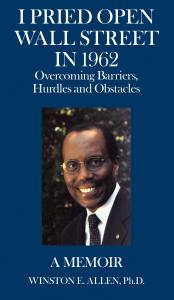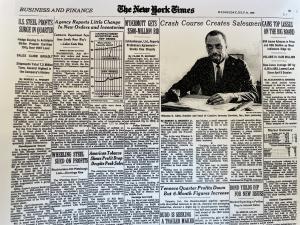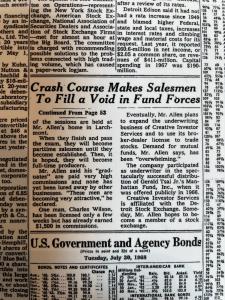NY Times Article Forever Changes Life of Dr. Winston E. Allen, Ph.D., Author of “I Pried Open Wall Street In 1962.”
Share the 55th anniversary of the life changing event in 1968 that changed the life of Winston E. Allen, Ph.D., Author of “I Pried Open Wall Street In 1962.”
Winston explained that he was an independent broker-dealer on Wall Street. The questions quickly continued, and Hal learned that Winston had recruited and trained over 65 people, primarily blacks from dead-end jobs to pass the National Association of Security Dealers (NASD) Series 7 Exam to enter Wall Street.
Hal Levine was so impressed that he immediately presented Winston with his business card which showed that he was President of the Hal Levine Public Relations Firm located in the Pan Am building at Grand Central Station.
Winston explained that over 95% of his novice applicants passed his Crash Course on the first and only try, as failure to pass the NASD exam after completing his grueling course, meant no position with Winston’s firm, Creative Investor Services, Inc.
He asked Winston to come to his Park Avenue office on Wednesday and Winston was surprised when he arrived at noon and Hal Levine immediately asked him to rush over to the Algonquin Hotel, four blocks away to meet Robert Hersey, Jr, Senior Financial Editor of the New York Times.
Mr. Hersey peppered Winston with question after question, for three hours, about how he created a one-month crash course to train people to pass the NASD exam and what was his formula for success.
The following morning when Winston drove down to Fordham University’s temporary office building and entered his classroom for his course in statistics, Dr. Waldron, his professor said to the class, “We have a celebrity in our midst.” “You are going to receive so much mail and phone calls, so take off the rest of the morning off, go home and catch up on your contacts.” Then the professor held up the NY Times paper and Winston discovered that he was featured on the front page of the Business and Financial Section in the newspaper in a two-page story entitled “Crash Course Creates Salesman, he was astounded.
After receiving applause Dr. John Waldron said to Winston “You are going to receive so much mail and phone calls, so take off the rest of the morning off, go home and catch up on your contacts.” Sure enough, the professor was correct.
When Winston arrived home, Winston found many notes left in his mailbox and numerous phone messages left on his answering machine. Winston was overwhelmed and found it difficult to respond to all. One request was for Winston to be a featured guest speaker on WOR’s Television Show, Stock Market Observer which he accepted. Another immediate contact was from Donald Spiro, Chairmen and CEO of The Oppenheimer Funds.
Don Spiro asked if he could come to Winston’s home in Riverdale, New York, for a face-to-face meeting. During this meeting, Don Spiro proposed to Winston that he personally present a few financial strategies at Winston’s upcoming public seminar about Wall Street. This was the beginning of a long and fruitful relationship between Don Spiro, Winston and his company.
Another result of the New York Times article was that Jack Dreyfus, CEO of the Dreyfus Mutual Fund, contacted Winston and a relationship developed between Dreyfus Mutual Funds and Winston’s company, Creative Investor Services, Inc.
These contacts were only a few of the numerous relationships Winston developed due to the New York Times article.
In 1970, the biggest and most far-reaching outcome that came to Winston from the article was from C. Peter McColough, CEO of the 80 Billion Dollar Xerox Corporation. McColough’s wanted Winston to bring his innovative training techniques and technology to Xerox that proved to be successful in his company.
Based on Xerox’s own initiated audit, the implementation of Winston’s training program, produced 25% greater sales while reducing the cost of training by 30%. Due to Winston’s efforts, Xerox nicknamed the training center “The Xerox University.” Three years later, Winston was promoted to Corporate Headquarters in Stanford, Connecticut, developing the international research and development strategies for Rank Xerox, frequently traveling to Europe, meeting with corporate managers, supervising the implementation throughout Europe.
Winston remained with Xerox for 10 years and retired at the same time as C. Peter McColough in 1981. Immediately after his retirement from Xerox and due to the New York Times article, Mark Greenberg, a real estate developer in New York, approached Winston and asked him to syndicate hundreds of deluxe Manhattan apartments that were being converted from rental to co-op apartments and sold as Unsold Shares. As a result, Winston purchased 25 NYC apartments outright at 220 Madison Avenue in Manhattan.
There are so many examples of how the July 31, 1968 ,New York Times article changed Winston’s life and so many others that he recruited and trained and reached throughout the world.
For close to fifty years, Winston E. Allen, Ph.D., continues to reside in Westport Connecticut.
Winston E. Allen, Ph.D.
John Scifo
516-528-7677 or 1-203-227-4897
email us here
Visit us on social media:
Facebook
Twitter
Instagram
Trailer for ''I Pried Open Wall Street In 1962"
Legal Disclaimer:
EIN Presswire provides this news content "as is" without warranty of any kind. We do not accept any responsibility or liability for the accuracy, content, images, videos, licenses, completeness, legality, or reliability of the information contained in this article. If you have any complaints or copyright issues related to this article, kindly contact the author above.



